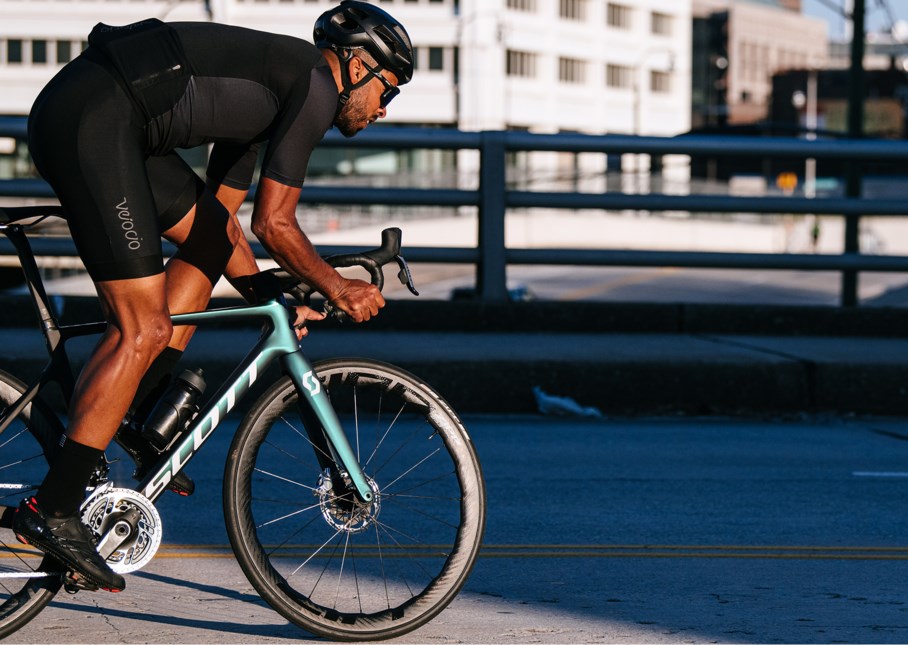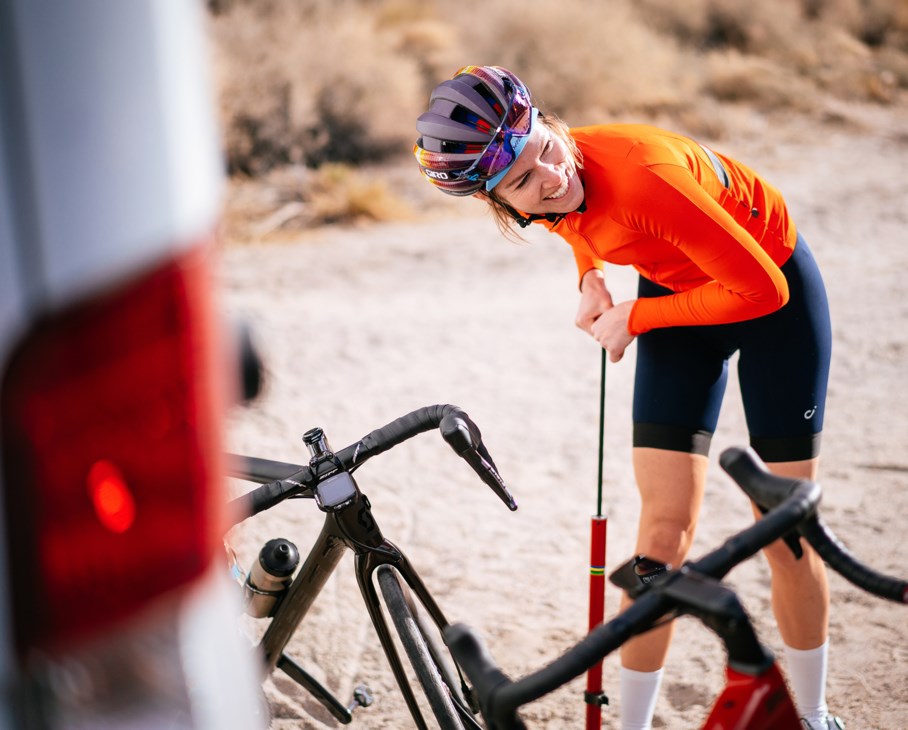TALKING TIRE PRESSURE FOR ZIPP WHEELS
Wheel Design Engineer Mike Vittorio reveals details to why he lowered PSI
Zipp Senior Design Engineer Mike Vittorio is an air head of sorts. (We hope he’s not insulted by this!) It’s just that Mike thinks about air pressure. A lot. So, we sat down with Mike to ask him all about tire pressure basics and guidelines for Zipp wheels featuring our new Total System Efficiency design approach and hookless technology.
We sat down with Mike to talk all about tire selection and tire pressure for modern road riding:
Zipp’s current wheels are designed with our Total System Efficiency approach and feature a hookless rim-tire interface. What basics should riders know about each?
The term hookless refers to tire bed shape at the outer diameter of the rim. Traditional road rims had a hook (called crochet, French for hook, in cycling design parlance) required to retain the tire, so the “hook” is necessary on standard clincher tire design. Our latest rims do not have a hook and are straight sided. Hookless rims rely on the tension in the tire bead to retain the tire to the rim.
Total System Efficiency, or TSE, is the way we began approaching design with this latest iteration of Zipp Firecrest and NSW wheels. Previously, our primary focus was on reducing the aerodynamic drag of a wheelset— an “aero is king” approach. Now, we treat the wheel, tire, and bike as a system and consider all the factors that contribute to the force required to push the pedals (wind resistance, weight, rolling resistance, and vibration) and optimize that system to the given riding environment. By taking this wholistic approach we have been able to produce our fastest wheelsets ever.

Let’s start at the beginning. You’ve bought a new set of Zipp Hookless/TSE wheels. You unbox them and are eager to ride. First let’s talk tire selection. Could you go through what people should think about as far as widths for different disciplines?
For road riding, a great place to start on our new tubeless wheelsets (such as 303 Firecrest) is with 28c tires. What’s more, 35c tires with very light or no tread work great with mixed pavement with light gravel and/or hard packed dirt. As the gravel gets bigger or there is a mix between gravel and single track, I would recommend 40c or bigger tires. The model of Zipp wheel you ride, and its internal width, also influence optimal tire width.
We get a lot of questions about tire selection. Without endorsing any brand (except ours!), what should people look for?
For tires, a rider should follow the same mentality that we do with Total System Efficiency. They should consider the environment they are going to be riding in, and then optimize for those conditions. The Zipp selection of tubeless tires is a great place to start for both road and gravel. In regard to compatibility, I will refer to Zipp’s official stance, “(Zipp hookless wheels) are compatible with tubeless or tubeless-ready tires unless the tire manufacturer specifically prohibits the use of their products on tubeless hookless (straight side) rims.”
We have a 73 PSI limit on our Hookless TSE wheels. That is quite low relative to historic standard tire pressures. How did we get to that limit?
That limit is driven by the ISO standards for a hookless tubeless bicycle rim. But this is no limiter because we are in a new era of tire pressures. Historical standard tire pressures typically were driven by the assumption that a smaller contact patch = lower rolling resistance. The higher tire pressures in standard clinchers using tire/tubes also was to prevent pinch flats.
Listen to Zipp Speed Podcast
What effect do larger tires and lower pressures have on aero performance? What about the effect of the hookless rim-tire interface?
Running larger tires does affect aerodynamic performance; however, it is not as simple as stating that larger tires are slower than skinny tires aerodynamically speaking. For zero-degree yaw (or incoming wind flow directly in front of the wheel) nothing beats an infinitely thin flat plate, meaning the skinny tires win out. But that picture starts to change the moment you have some amount of yaw angle or off-center incoming flow. This is because the tire and rim start acting like an airfoil and are now producing lift. If you design your rim to match the profile of larger sized (28-32c) tires, then the aerodynamic penalty is quite low and can be outweighed by the efficiency gains from large tires with the reduction in rolling resistance, better vibration damping, and increased corning grip. This is where the real magic lies within the TSE approach to wheel design. To circle back to the second part of your question, the hookless interface provides a better transition between the rim and the tire and improves the overall aero performance for a given tire size.
Let’s give specific examples on tire pressures for riders of different weights. Please give examples of riders using the new Continental Grand Prix 5000 S TR in sizes 700x28, 700x30 and 700x32?
First, I am going to use this question as a plug for our excellent tire pressure calculator tool. The tool is web based and easily found by googling “AXS tire pressure guide.” I’m happy to talk through some specific combinations using a Zipp 303 Firecrest as an example. However, riders should always keep in mind that our recommendations are just a starting point and are encouraged to find the right pressure for their given setup:

We can talk gravel in a minute, but how does different pavement change optimal tire pressure? Mostly smooth blacktop vs. chip and seal or deteriorated roads?
Pavement makes a big difference on what tire pressure someone should run. Personally, I would drop my pressure roughly 4psi if I knew that my ride was going to be consistently on chip and seal roads vs. smooth blacktop. Most routes are going to have a mix of various surface types. In those conditions, I would recommend hedges on the low side: the benefits of being lower pressure on the rough conditions outweigh the penalty on smooth surfaces in terms of watts saved.
When does tire pressure get too low?
It is true that there is a bottom end for tire pressure. For tubeless this limit is likely going to be determined by puncture performance from impacts, whereas in previous years with clincher tires with tubes it was driven by innertube snake-bite punctures and loss of handling performance from squirm while cornering.

If lower tire pressure is better, please address why track racers going after records on the velodrome like Ashton Lambie still run pressures way over 100 psi?
This goes back to Total System Efficiency and designing (or changing your setup) for the given riding environment. The track is much different than the typical roads we all ride. The perfectly smooth surface, lack of wind, and high speeds seen on the track mean that the primary forces contributing to drag are aerodynamics and rolling resistance. Thus, Ashton and other track athletes go for deep, narrow rims or discs with skinny tires at high pressures with the aim of reducing their surface contact patch.
Please contrast the tire/pressures you ran when you started working here to what you run now?
With regards to both tire size and pressure it has been quite the journey from when I started to what I run now. I started at Zipp running 23c tubed tires at 110psi. The setup on my road bike currently is 30c tubeless tires on 303 S rims set at 50psi front and 52psi rear. Quite the difference!
Front/rear PSI recommendations
Zipp Tire Pressure Guide
Dig the science? A Deep Dive Below
TSE White Paper